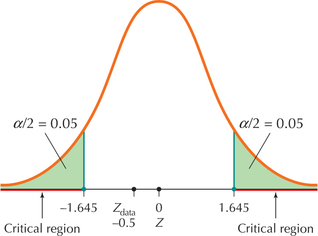EXAMPLE 26 Z test for p using the critical-value method
As a check on your arithmetic, the two quantities you obtain when checking the normality conditions should add up to n. Here, 80+320=400=n.
Refer to Example 25. Test whether the population proportion of Chromebook computers has changed from 20%, using the critical-value method and level of significance α=0.10.
Solution
First, we check that both of our normality conditions are met. From Example 25, we have p0=0.20 and n=400.
n·p0=(400)(0.20)=80≥5andn·q0=(400)(0.80)=320≥5
The normality conditions are met and we may proceed with the hypothesis test.
Step 1 State the hypotheses.
From Example 25, our hypotheses are
H0:p=0.20versusHa:p≠0.20
where p represents the population proportion of computers that are Chromebooks.
Step 2 Find Zcrit and state the rejection rule.
We have a two-tailed test, with α=0.10. This gives us our critical value Zcrit=1.645. the rejection rule from Table 11 is: Reject H0 if Zdata≥1.645 or Zdata≤-1.645 (Figure 35).
FIGURE 35 Zdata does not fall in the critical region.
Step 3 Calculate Zdata.
From Example 25, we have Zdata=-0.5
Page 546Step 4 State the conclusion and the interpretation.
The test statistic Zdata=-0.5 is not ≥ 1.645 and not ≤ -1.645. Thus, we do not reject H0. There is insufficient evidence at level of significance α=0.10 that the population proportion of computers that are Chromebooks differs from 20%.
NOW YOU CAN DO
Exercises 15–18.